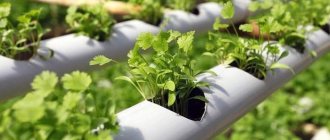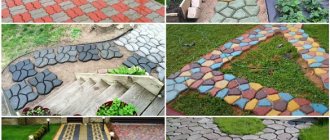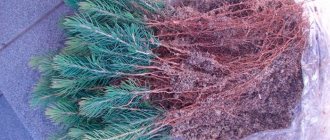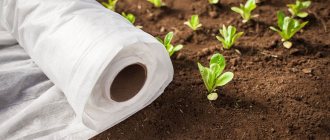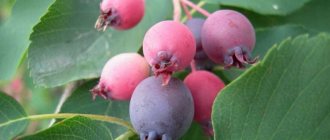So, dear friend, one day you woke up early in the morning... And you decided to change something in your life, discover new facets and join the “secret brotherhood” of growers... First, you need to soberly assess your strengths and understand which method of cultivation to associate your exciting hobby. Remember that growing hydroponically for a beginner is a complex, time-consuming and quite expensive process. Most people choose to grow plants using soil or substrate to begin with. However, if you feel strong and don’t want to waste your time on trifles, in this article we will tell you where to start and what equipment you need to purchase.
What is hydroponics?
In fact, this is simply growing plants WITHOUT SOIL.
With the hydroponic growing method, the plant receives all the necessary nutrition from a special solution. There are three main hydroponic methods of growing plants:
- aquatic culture - hydroponics ;
- substrate culture - hydroculture ;
- air culture - aeroponics .
Purchased home hydroponics systems can be plastic or metal. It is very good if such systems are equipped with phytolamps.
Pros and cons of hydroponics
Traditional farming and hydroponics are different concepts, but growing crops at home has many advantages. Let's take a look.
- Reduced labor intensity. You don’t need to go to the garden, remove weeds, dig up the crop, water it often, etc. And there won’t be any pests (moles, beetles).
- Growing plants at home. It is not necessary to have a plot. In addition, a large area is also not required.
- A large amount of high-quality harvest, with minimal costs. You get an environmentally friendly product grown yourself. It did not pick up nitrates, harmful compounds, and heavy metals from the soil.
- Easy to care for. No odors, pests, dirt, etc.
- If necessary, the plants can be easily replanted.
Among the large number of advantages, there are two disadvantages:
- High cost compared to conventional cultivation.
- Do-it-yourself hydroponics for cucumbers and tomatoes is a labor-intensive task that requires effort and desire.
Benefits of home hydroponics
- It is modern, technologically advanced and accessible to everyone!
- Almost any plant can be grown.
- There are automated solution circulation systems (you can assemble it yourself at home), which reduce labor costs for watering and fertilizing to a minimum.
- When grown using the hydroponic method, a plant receives the substances it needs in the required quantities, so it grows healthy and much faster than in soil.
- Plants in hydroponics can be left for a long period of time without any care at all (departures, vacations, long weekends, summer holidays).
- There are no soil pests with the hydroponic growing method!
Flowering/Fruiting
If you have flowering and fruit-bearing plants, then this stage has its own conditions. As a rule, to transition to the flowering phase, a plant needs a change in lighting conditions. Based on the reaction to the length of the day, we can distinguish:
Long day plants include cabbage, turnips, radishes, radishes, carrots, beets, parsley, onions, lettuce, spinach and dill.
Short-day plants - beans, peas, cucumber, tomato, watermelon, melon, pumpkin, pepper, eggplant, corn.
To transition to flowering and fruiting, long-day plants need 14-17 hours of daylight. Short-day plants, on the contrary, bloom and bear fruit faster in conditions of a day shortened to 12 hours. So, if you have tomatoes or cucumbers in hydroponics, then the lighting mode should be changed from 18\6 to 12\12.
Conditions for flowering and fruiting: humidity 30-50%, lighting mode 12 hours light/12 hours dark, ambient temperature 22-26 °C, solution temperature 18-24 °C. Be sure to monitor the pH level 5.5-6.5, and the EC level 1.4-1.8.
Apply fertilizer according to the schedule for the flowering stage. Please note that the proportions of fertilizer components may change from the phase when the inflorescences have not yet formed, but the lighting regime is already 12/12, to the phase when the inflorescences have already formed.
Between the growing season and flowering (at the moment when you change the lighting mode), the solution must be completely changed. Prepare a solution with a dosage for the first weeks of flowering (before the inflorescences appear), then measure the EC level and add either clean water or a fertilizer solution. Once every 1-2 weeks you can change the solution either completely or by 2/3. If everything is growing well, it’s better not to rush to change it again. The main thing is to maintain the pH and EC levels and monitor the growth of the plant and its condition.
You can find out more about the features of the flowering stage of a plant in hydroponics here.
How to make a simple hydroponic system yourself
The simplest hydroponic system is onions in a glass of water!!! Everyone does it).
Simple Home Hydroponics System
It can be a little more complicated: take a plastic pot for indoor plants (you can take any other container, most importantly inert and preferably not letting in light, for example, a two-liter bag of juice placed on its side can perfectly play the role of a hydroponic container).
Nutrient solution for hydroponics
Regular drinking water is suitable for the nutrient solution. Of course, professionals who grow huge hectares of hydroponic crops in greenhouses will not agree with this. They will say that the water must be purified, without chlorine, without pathogens, etc. But for home growing, ordinary water passed through a filter will do, BUT, if you want EVERYTHING BY THE RULES, then have fun! Buy distilled water, purify yours, recharge from Kashpirovsky (oops, something has gone wrong...)
In order to make a nutrient solution from ordinary water, fertilizer must be added to it. In order not to rack our brains and make complex collections from various fertilizers, experts have created specialized fertilizers for hydroponics, for example,
Plagron Hydro AB is a highly concentrated mineral-based fertilizer that contains all the necessary microelements in the form of chelates (DTPA). Can be used with any type of neutral substrate. Add no more than 1.6 ml of each composition per 1 liter of water.
Hesi - the presence of a normal amount of nutrients, occurs due to a high concentration of chelates. Composition of trace elements: potassium 25%, nitrogen 30%, phosphorus 14%, vitamins, amino acids, enzymes and vegetable sugar.
GHE Flora Series is the original three-component fertilizer system. Contains all the basic and auxiliary microelements necessary for balanced plant nutrition, which helps to increase the yield and improve its quality. Provides the plant with nitrogen, phosphorus, potassium and secondary elements.
You can assemble a hydroponic system yourself
How to properly grow plants in hydroponics?
IMPORTANT! To provide the root system with oxygen, only part of the roots is immersed in the nutrient solution. The root collar of a hydroponic plant is secured with cotton wool or foam rubber (there are special neutral substrates that can be purchased) on the lid of the pot .
1/3 of the roots were in the nutrient solution, and 2/3 of the roots were in the air space (between the solution and the lid of the pot).
Seedling
The very first pair of leaves are cotyledons. These will be followed by the so-called true leaves. And when there are already 2-3 pairs of real leaves, you can start applying fertilizer. Be careful with the dosage - the roots and the plant itself are still small and require extremely small amounts of nutrients. And since most fertilizers for hydroponics are highly concentrated, an overdose can lead to the death of seedlings. Conditions for seedlings: humidity is still high 80%, lighting is not intense and around the clock, ambient temperature is 22-26 ° C, solution temperature is 18-24 ° C.
Using only natural light from a window may not be effective, especially in winter with short days. It is better to install at least one lamp - LED or CFL (phytolamp), or even a whole lamp. The compressor in a hydroponic system must run 24 hours a day. Be sure to monitor the pH level 5.5-6.0, the EC level (salt content in the solution) 0.4-0.8 – if possible. You can continue to add root stimulator.
In the article “Seedlings are a delicate matter!” You can learn more about raising seedlings using the soil growing method.
What indoor plants can be grown hydroponically?
Unpretentious plants with large roots are chlorophytums, many aroids, ivies, asparagus, and epipremnum. For hydroponic culture, it is better to take a small specimen.
How to transplant a plant from soil to hydroponics?
1. Water the plant generously one day before.
2. Separate the soil from the roots UNDER WATER and rinse the roots thoroughly.
3. Carefully place the roots of the plant in the inner pot, trying not to damage them, insert some of the roots into the holes in the pot (you've probably seen lettuce pots in grocery stores!? So this is an inner pot for hydroponics, you also need something in this kind) and lower it into the solution by a third. At first, use a diluted (1:10) nutrient solution.
4. After a week or two, bring the concentration of the solution to the concentration recommended on the package.
Technology of growing plants using the hydroponic method
Now let’s talk about the technology of growing hydroponics.
Germination of seeds
First you need to germinate the seeds. This can be done in a special substrate, in soil or on water. The second method is used less frequently, because Before transplanting the plant into a hydroponic installation, you will have to thoroughly rinse the root system to get rid of the soil.
When the first true leaves appear, the plant can be transplanted to a permanent location.
Transplanting seedlings to a permanent place
Pre-fill the grow container with water and check the operation of the pump and compressor.
It is recommended to add nutrients to the solution only after 5-7 days. Moreover, it is better to do this gradually, in several stages: first, the concentration of the solution should be about 33%, then 66%, and only then 100%. Stop introducing fertilizers into the solution 3-4 weeks before harvesting.
Place each seedling in a separate pot filled with the substrate of your choice. If the seedling has long roots, pull them through the holes in the bottom of the pot.
Further care of plants
In the future, regularly monitor the growing process:
- check the pH level of the solution: it should be about 6.0;
- control the temperature and humidity of the environment - these characteristics must meet the requirements of the crop being grown;
- provide the lighting the plants need;
- constantly check the solution level in the tank and add liquid as necessary;
- Harvest the grown crop on time.
Hydroponics is still a frightening unknown for many. However, due to its advantages, this method of cultivation is becoming increasingly popular not only among specialists, but also among ordinary people. Join us!
Ready-made hydraulic systems
There are several types of hydrosystems designed for growing indoor plants hydroponically. Modern systems usually consist of two pots.
Ready-made home hydroponics system. These are usually used to grow short herbs for the kitchen: parsley, basil, dill.
Substrate is an inert substance that, unlike soil, does not supply plants with any nutrients - all life support comes from solution.
Installation for strawberries
If vegetable crops can disrupt the interior of the room, then strawberries or wild strawberries, on the contrary, complement it. The berries give off an attractive aroma. For plants, purchase a “vertical garden”, “green wall” installation, and other equipment from manufacturers.
For strawberries, a multi-tier system is made. To decorate the room, they use vertical home hydroponics. To assemble it, you will need the following materials:
- PVC pipe 110 mm, length 1.5 m;
- for planting strawberries, use 300 ml cups, 8 cm in diameter;
- cups are applied to the surface to make markings for the holes; they are arranged in a checkerboard pattern, in increments of 20-30 cm;
- a tube with a diameter of 3-4 cm is installed in the module; holes are made in the upper part; the solution will pass through them into the module;
- a 15 liter plastic tank is provided for the solution; a pipe is installed in it;
- A plug is installed on the bottom of the pipe; a pipe for irrigation is attached to it; it is secured to the module from above with metal loops;
- for stability, gravel is poured into the pipe in a layer of 5 cm;
- at a height of 15-20 cm, a cut is made in the module into which a mosquito net is installed; this is a filter; it prevents expanded clay from getting into the tank with the solution;
- A pump is installed in the tank, which pumps the solution into the system.
We recommend: What is the difference between aeroponics and hydroponics?
Strawberry seedlings are placed directly into cells, on a pipe, sprinkled with expanded clay on all sides, but in this case the substrate may fall out of the holes. To prevent this from happening, use planting cups.
The hydroponics is turned on, the pump begins to pump the nutrient solution into the irrigation tube. Liquid enters the module from above. The pump is connected to a timer. Watering continues for 5-7 minutes, every 20 minutes.
The solution tank can be closed with a lid. A hole with a diameter of 112 mm is made in it. There is a gap between the module and the cover. It is intended for the solution if it will drain from the outside of the pipe.
Strawberries develop normally at a temperature of 20 0C during the day and at 15 0C at night. LED strips are used for additional lighting.
On such an installation you can grow lettuce, spinach, and decorative flowers. The column is also used for tomatoes and cucumbers, but planting is carried out only in the upper cells. This is due to the fact that the plants are climbing plants. Branches and lashes descend along the column. They are not tied up, but the stems are pinched.
Hydroponic bell pepper
Bell peppers are a plant for slightly more advanced gardeners. They should not be allowed to grow to their full height; it is better to cut and pinch them at a height of twenty centimeters to speed up the growth of the peppers. Deep water culture system and intermittent flooding system work best for peppers.
- Ideal system: Deep water culture system, intermittent flooding system;
- Duration of cultivation: about 90 days;
- Best pH level: 6.0 to 6.5;
- Note: Please note that this plant requires eighteen hours of daylight, and be sure to raise the light level as the pepper grows, keeping the distance between the plant and the light within 15 cm;
- Variety options: California Wonder, Yolo Wonder.
Where to start a business?
Organizing a business requires planning. The business plan should include the following aspects.
What to grow
The priority is the issue of choosing a crop for cultivation. This:
- ordinary vegetables - most often tomatoes, cucumbers, peppers;
- greens: parsley, dill, cilantro, lettuce, onion;
- berries (usually strawberries), except for large bushes;
- flowers;
- seedling;
- medicinal herbs.
Hydroponic installations are successfully used for germinating grain, solving the issue of providing animals with green food in the winter. Like a business in any industry, hydroponics must take into account the needs of the market in a given region. The future harvest also largely depends on the chosen variety.
The principle of growing strawberries hydroponically in a greenhouse.
Where to sell products
You can sell your products to stores, wholesale centers and markets. But then it will have to be sold at a low price, which is not profitable for the farmer. It's better to open your own point of sale. It’s a good idea to establish connections with a processing plant, restaurants, and cafes. In any case, we need to solve the problem in such a way as to do without intermediaries.
Where and how to grow
Knowing which culture to take as a basis, you need to choose a room. You can use any, but unsuitable ones will require extra costs associated with lighting. The best option is a greenhouse.
With hydroponic production, it will be most cost-effective to grow produce year-round.
Therefore, to maintain the required temperature during the cold season, it is necessary to insulate the building or provide heating inside.
It has been verified that heating costs will be reduced by a third with high-quality thermal insulation.
Manufacturing control
It is necessary to combine theory and practice. Solving problems that arise during the production process, monitoring the operation of all systems, establishing and maintaining connections with business partners are the tasks of the manager. Success in business depends on how competent his actions are.
Financial analysis of production
It is necessary to take into account expected and actual expenses and income, which will help make proper planning for the future.
How much money do you need to start a business?
In order to organize your own hydroponics business, you need a decent investment. Even if you decide to create a small farm with a retail outlet attached to it, you will need from 10-25 thousand dollars.
The main expenses of a hydroponic business are:
- construction of a greenhouse or rental of appropriate premises;
- hydroponic installation;
- seeds and substrate;
- shields, containers;
- lighting;
- systems for water purification and space heating;
- backup electric heaters;
- refrigeration units;
- fuel storage tanks;
- electric generators.
In addition to the listed costs, you need to pay for business registration, conduct an advertising campaign, and also resolve all administrative issues, which also require certain financial costs.
What documents are needed
The list of necessary documentation that each organizer of this business must prepare includes standard papers for an individual entrepreneur or LLC, as well as permits from the SES, fire inspectorate and (in some cases) local authorities. In addition, you need to conclude agreements with all contractors, obtain laboratory test results confirming the quality of the grown products, and sign employment contracts with staff. The last document must contain a clause on non-disclosure of information related to hydroponics.
Hydroponics is a method of growing plants without soil, in which all the substances necessary for nutrition are obtained from an aqueous solution.
Although some gardeners are still somewhat skeptical about the hydroponics method, it has long been widely used in the home, despite the fact that it does require some expense.
The idea behind the method is quite simple: in order for plants to grow and bloom, they need light, air, water, heat and nutrients. Soil is not so necessary if the roots can obtain the minerals necessary for plant growth from the nutrient solution.
Sometimes it can be quite difficult to decide to switch from growing plants in soil, which is so familiar to us, to such a complex, at first glance, method called hydroponics.
Hydroponic gardening can be very complex, with computers and sensors controlling everything from watering cycles to the concentration of nutrients in the nutrient solution to the amount of light the plants receive. On the other hand, hydroponics can be incredibly simple, a bucket of sand with one plant and hand watering. Most hydroponic systems fall somewhere between the two extremes mentioned above.
In our article we will try to guide you in the “right direction” and, we hope, our advice will help you grow such beautiful, pleasing plants using hydroponics.
First, decide what you will grow
Almost all types of plants can be grown hydroponically. But do not forget to take into account that there are a number of conditions by which you can determine that plants are suitable for growing hydroponically:
Plants that do not require cool wintering, i.e. wintering at a temperature not lower than 15°C, otherwise there is a possibility of root rot;
Plants with a compact root system (i.e., not growing much) - otherwise you will have to change the pot too often;
Plants that do not form tubers or rhizomes, because again there is a possibility of root rotting.
As a rule, only perennial plants are used for hydroponics. The most common vegetable crop grown using soilless methods is the tomato. In addition to it, onions, lettuce, kohlrabi, cucumbers, radishes, strawberries, peppers, lemon balm, mint, etc. grow well. The most picky plants living on a nutrient solution are philodendron, ivy, phalangium, ficus, fatsia, hoya, asparagus, anthurium, indoor linden, coleus, begonia of all varieties, cissus, monstera, dracaena, cactus, succulents, and orchids.
Having chosen the crop to grow, decide where you will install the equipment
For this purpose, a plot of free land on which you can build a heifer with a film or glass coating, an unused production room, a warm hangar, an old greenhouse, an attic, a balcony window sill, etc. may be suitable.
Choose the hydroponic system that suits you
There are 6 main types of hydroponic systems: deep water culture, periodic flooding, drip irrigation (reversionary and non-reversionary), nutrient layer, aeroponics, wick system. Additionally, there are many modifications based on the basic systems, but all hydroponic systems are a variation or combination of these six types.
When choosing a hydroponic system, do not forget that there is no concept of “the most productive system” - the choice of a hydroponic system depends on the conditions in which it is installed and your capabilities - how many plants will be in the system - how much time you are willing to spend on maintaining the system, etc. The yield depends on a number of factors not directly related to the type of hydroponic system, first of all, the correct conditions for keeping the plants - temperature, humidity, photoperiod, nutrient solution, watering, sufficient lighting, etc.
Select the equipment you need
To start your activity as a grower, we will advise you to use a special hydropot, which you can make yourself. It consists of an outer decorative vessel and an inner one, which is usually made of plastic. The bottom and walls of the inner vessel are equipped with holes so that the roots can receive enough oxygen and minerals. The outer vessel should be stable, comfortable and beautiful. It is best if the outer vessel is made of opaque material - protection from sunlight will prevent the water in the inner pot from blooming.
Plastic containers are the most common, but there are also ceramic ones and those made of metal (plastic-coated only) or wood (plastic- or film-coated). Home hydroponic systems usually consist of several main parts: a reservoir with a nutrient solution for the roots, a timer that controls a submersible pump for watering, and a compressor with an aerator to oxygenate the nutrient solution.
Substrate selection
First, let's define what a substrate is - this is what plant roots grow in. The best substrates: hard rock sand and gravel (granite, quartz, river pebbles), porous materials (pumice, slag, crushed brick), vermiculite, you can also use a mixture of peat chips with deep-fiber peat, etc.
When choosing a substrate, keep in mind that the substrate must have the following properties:
- it is easy to pass air and solution, it is well wetted by it;
- do not interact chemically with dissolved substances;
- have a slightly acidic or neutral reaction.
Thus, substrates must be free-flowing, chemically inert, hold the nutrient solution well and at the same time facilitate its drainage. However, it should be taken into account that salts accumulate in the pores of such a substrate over time, inhibiting plants. Plant roots must be well supplied with air.
The substrate is selected depending on the type of hydroponic system. Some systems require very little substrate (only to keep the plant trunk upright and the roots free) - these are the systems: Deep water culture / Nutrient layer / Aeroponics. For other systems, most or all of the space in the reservoir with plant roots is filled with a substrate (such substrates are often called soil substitutes) - these are systems: Drip irrigation / Wick.
The characteristics of the substrate in terms of water absorption and retention are very important. If watering cycles are interrupted, the roots can quickly dry out - this is especially true in systems where the roots are not completely immersed in the substrate (Nutrient layer / Aeroponics). In systems where the roots are completely in the substrate (Drip irrigation/Wick), this problem can be slightly reduced by using a substrate that retains more water: mineral wool, vermiculite, coco soil. There are systems in which drought of roots is impossible (Deep water culture), but if the compressor is interrupted, the plant may also die. Gravel, expanded clay, and perlite do not retain water well; they are usually used in a mixture with moisture-intensive substrates.
With proper use, granite and quartz substrates can be used for up to 10 years, expanded clay and perlite for 6-10 years, and vermiculite for only 2-3 years.
Prepare the substrate
Sterilize by pouring potassium permanganate into a dark red solution for a day. Then drain the solution and rinse the substrate thoroughly with water. Substrates made from slag and pumice are additionally cleaned with a solution of sulfuric acid (1 liter of acid per 10 liters of water), and then washed several times with water. Before planting, moisten the substrate well for 2-3 days with water and a nutrient solution diluted in a ratio of 1:5. Drain off excess solution.
Nutrient solution
Nutrient solution for roses, orchids, antarium, poinsettia, gerberas, strawberries, tomato, cucumber, eggplant, patuca, basil
You can prepare it from commercially available complex fertilizers in the proportions indicated on the package. Before the plant bears fruit, reduce the concentration of the solution by half so as not to burn the young roots. Having gained experience, prepare the solutions yourself, taking into account the phases of plant development.
There are a huge number of nutrient solution recipes, but it should be noted that each solution for hydroponic culture is suitable only for a certain group of plants, for example, Knop's solution is suitable only for those plants that need a high calcium content. Some gardeners use highly diluted solutions of complex fertilizers as solutions for hydroponics. However, it will be possible to understand whether the solution is suitable for the plant only after some time, judging by its growth and development.
Completely replace the nutrient solution every month in the summer, every 1.5 months in the winter, and also when it becomes cloudy, since over time an imbalance in the proportions of nutrients occurs in the solution. Before replacing the solution, rinse the substrate with water. Monitor the pH value of the nutrient solution - a measure of the acidic and alkaline properties of the solution. The optimal pH value for growing vegetables should be 5.5 - 6.5, that is, the solution should be slightly acidic. Check the pH of the nutrient solution periodically (once every 1.5 - 2 weeks) using a pH test. pH control is extremely important—when pH changes, plants lose their ability to absorb various nutrients.
In the case of transplanting a plant grown in a soil mixture to hydroculture, fulfill a number of conditions on which the further successful development of the plant will depend:
- do not damage the root system when removing a flower from an old pot, so water the soil thoroughly before replanting;
- It is best to lower the removed plant with its roots into a bucket of warm water along with all the soil that does not separate immediately, lightly rinse the roots in water, then free the roots from the soil with your hands, and also remove all rotten or damaged areas using scissors. If there are too many damaged roots, do not plant the plant hydroponically on the same day, but place it in a pot of warm water for 2 days with the addition of several tablets of activated carbon (10 tablets per 1 liter of water);
- pour a little washed expanded clay or other filler into the inner pot, set the liquid level indicator. Place the roots of the plant, straighten them, add the rest of the expanded clay to the top of the pot. Place the plant pot in an outer vessel, fill it with water at room temperature or slightly warmer until the float shows the optimal liquid level.
A plant transplanted from soil does not need to be immediately placed in a nutrient solution; it must stand for some time in ordinary water. It is better to add the nutrient solution and fertilizer when the first batch of water has evaporated and the level float drops to the minimum amount of liquid mark (after about two weeks).
Conditions for growing plants
Monitor the temperature and humidity conditions, the intensity of the light flux. These parameters are individual for each type of plant that is cultivated and the period of plant development (vegetative development, flowering, fruiting).
Learn to observe:
Inspect leaves, stems, flowers, fruits, soil or substrate. During the growth period, it is advisable to do this daily and, soon, you will be able to determine if something is wrong with the plant. The reason may be the environmental conditions in which the plant grows and develops or a change in the composition of the nutrient solution, which must be corrected in a short time. Remove all fallen leaves, flowers, dead parts of the plant to avoid contamination of the substrate, nutrient solution, otherwise various diseases and pests may appear. React in a timely manner when the first signs of diseases and pests appear, isolating diseased plants and taking the necessary measures. If you care for the plants properly, they will respond to you with excellent growth, flowering, fruiting, thanking you for taking care of them.
Regardless of whether you grow plants in a soil mixture or on an inert substrate, do not forget that the plant requires attention: light, warmth, water, humidity, fertilizing, rest, fresh air, pruning - this is an incomplete list of plant needs. Each plant is special and each plant must be treated differently to meet the specific core requirements of each. We should not forget that excesses are harmful: be it too high an air temperature, excessive watering, abundant sun, high air humidity, or fertilizing in larger doses than recommended in the instructions.
We hope that our article will become your assistant in your endeavors and wish you optimism and success!
Source
Fresh greens in winter and summer
Hydroponics is an amazing technology, accidentally forgotten. They talk a lot about it, keeping silent that the invention dates back to antiquity. Do you remember how the luxurious gardens of Babylon, which grew in a mysterious way, without touching the ground with their roots, delighted the eyes of beholders? The miracle of the world is associated with hydroponics.
The word "hydroponics" has the "hydro" part in it. Immediately there is a direct indication of the use of water instead of soil. The technology has gone further: instead of ordinary water, a special nutrient solution is used.
The plant being grown is initially placed in a solid substrate, which is then immersed in a container filled with a working solution. From it, plants will receive useful substances in the required quantities if the system is constructed correctly. Craftsmen can make the design themselves, and others will purchase a ready-made one in specialized stores such as “Garden and Vegetable Garden.”

